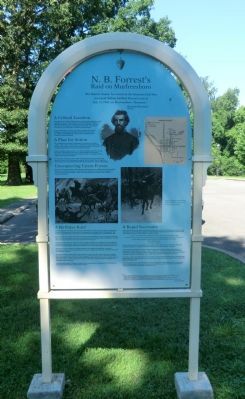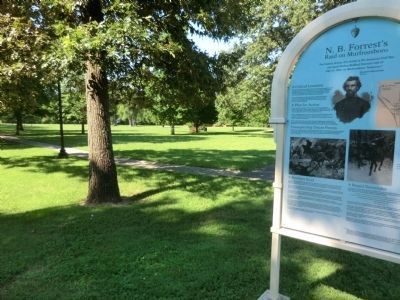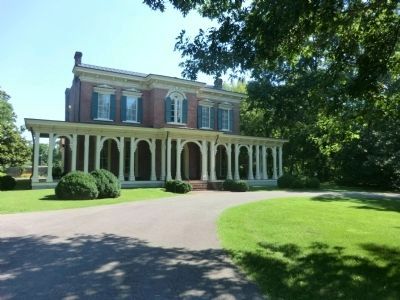Murfreesboro in Rutherford County, Tennessee — The American South (East South Central)
N. B. Forrest's Raid on Murfreesboro
A Critical Location
Throughout the Civil War, Murfreesboro was of strategic importance to the Confederacy and the Union because of its location along the Nashville and Chattanooga Railroad. After Federal troops took Nashville in February 1862, they set their sights on Murfreesboro for control of the railroad to Chattanooga and the roads to Alabama and Mississippi.
By July Murfreesboro became a key Union supply base along the Nashville & Chattanooga. 750 Federal infantry, 120 cavalry and one artillery unit defended the city and were encamped in three locations, including Oaklands.
A Plan for Action
The Confederates controlled Chattanooga in the spring and summer of 1862. They needed a strong cavalry commander to hold Chattanooga and drive Union forces out of northern Alabama and Middle Tennessee. Colonel Nathan Bedford Forrest was chosen for the task.
Forrest, a Middle Tennessee native, was 40 years old and described as being six-feet tall, with black hair, blue eyes, a muscular frame, and a serious disposition. He had raised his cavalry regiment at his own expense, and had fought in Kentucky and at Shiloh.
By June 1862, Union forces were within 35 miles of Chattanooga and depended upon the Nashville & Chattanooga for supplies. Forrest realized that by capturing Murfreesboro he would severely hobble the Union attempts to capture Chattanooga.
Unsuspecting Union Forces
Forrest and his approximately 1,400 men planned their attack from McMinnville, approximately 50 miles away. The Union troops in Murfreesboro included the Ninth Michigan Infantry and part of the Seventh Pennsylvania Cavalry under the command of Colonel W.W. Duffield, camped at Oaklands.
A Birthday Raid
July 13 was Forrest’s birthday. The day before the raid, he told the troops he wanted to celebrate his birthday in Murfreesboro. He then gave the command for an all-night ride to Murfreesboro. The brigade reached Woodbury about 11 p.m. and advanced on Murfreesboro via the Readyville Pike.
Forrest and his men slipped into town in the early morning darkness on July 13, riding up East Main Street. One division veered off to attack the Pennsylvania and Michigan forces at Oaklands while the other proceeded with Forrest to the courthouse and town square.
At approximately 4:30 a.m., the Maney family and the Union forces at Oaklands were awakened by the sounds of guns, shouts, bugles, drums and Rebel yells. Some surprised Union soldiers fell back over the fences separating the camp from the Maney’s yard while others sought shelter behind the trees.
The Union troops at Oaklands collected themselves and offered stiff resistance, driving the Confederates back toward Lebanon Pike by 8 a.m. Col. Duffield was seriously wounded and carried into Oaklands mansion.
According to Maney family history, the children of Lewis and Adeline Maney viewed the fighting from the mansion’s front windows. Relative Augusta Pickland Maney said in a late 1960s interview that Adeline told her “how she had to pull the children away from the windows and put them to bed during the battle. …They’d run from one window to the other. It lasted till daybreak and she was exhausted when it was over.”
While the battle raged at Oaklands, Forrest and his men attacked and captured the courthouse and city jail and released many citizen prisoners inside.
A Rapid Surrender
Around noon Forrest proceeded to Oaklands where he found the 9th Michigan guarding their camp and resting from the morning’s fighting. Forrest attacked, subdued them and sent a communication under flag of truce by one of his aides to Duffield. It read:
“Colonel, I must demand an unconditional surrender of your forces and prisoners of war, or I will have every man put to the sword. You are aware of the overpowering force I have at my command and this demand is made to prevent the further effusion of blood. I am, Colonel, Your obedient servant, N. B. Forrest, C.S.A."
Forrest soon received word of Duffield’s surrender, which is believed to have taken place inside the mansion around 1 p.m. Duffield remained at Oaklands for another month to recover.
Forrest then demanded the surrender of the 3rd Minnesota Infantry. He allowed the regiment’s commander, Colonel Henry C. Lester, to ride to Oaklands to confer with Duffield. During the trip across town, Forrest’s men gave Lester the impression of a much larger force by lining as many troops as possible along the route through town. Lester subsequently surrendered around 3 p.m.
The battle, which resulted in relatively few casualties ended with the remaining Union soldiers being taken prisoner for a short time. Forrest was promoted to brigadier general on July 21, 1862, eight days after his “birthday raid.”
Union forces soon reoccupied Murfreesboro and remained there until September. The Confederates held the city until their retreat after the Battle of Stones River in early January 1863. Murfreesboro remained under Federal control for the rest of the war.
Topics. This historical marker is listed in this topic list: War, US Civil. A significant historical date for this entry is January 12, 1863.
Location. 35° 51.341′ N, 86° 23.117′ W. Marker is in Murfreesboro, Tennessee, in Rutherford County. Marker is on North Manney Avenue, 0.1 miles north of Roberts Street, on the left when traveling north. The marker is on the grounds of the Oaklands Mansion. Touch for map. Marker is at or near this postal address: 900 North Maney Avenue, Murfreesboro TN 37130, United States of America. Touch for directions.
Other nearby markers. At least 8 other markers are within walking distance of this marker. Oaklands Mansion (about 300 feet away, measured in a direct line); a different marker also named Oaklands Mansion (about 300 feet away); The Maney Family (about 300 feet away); Wetland Plants and Animals (about 500 feet away); The Civil War (about 500 feet away); Agriculture and Gardening (about 600 feet away); Forrest’s Murfreesboro Raid (about 600 feet away); Known Confederate Veterans Among 2000 Buried Here (approx. 0.4 miles away). Touch for a list and map of all markers in Murfreesboro.
Also see . . . Oaklands Historic House Museum. (Submitted on October 9, 2013.)
Credits. This page was last revised on June 16, 2016. It was originally submitted on October 8, 2013, by Don Morfe of Baltimore, Maryland. This page has been viewed 873 times since then and 45 times this year. Last updated on April 20, 2015, by J. Makali Bruton of Accra, Ghana. Photos: 1, 2, 3. submitted on October 8, 2013, by Don Morfe of Baltimore, Maryland. • Bill Pfingsten was the editor who published this page.


